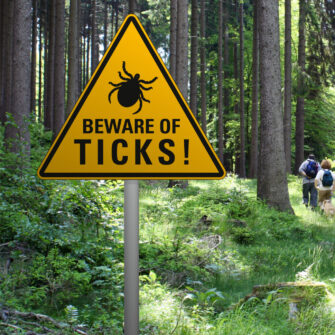
Get the tips! Stop the Ticks!
It’s important to be aware of ticks during the warmer months such as spring and summer since that is when they are most active. We have four types of ticks in Nevada:
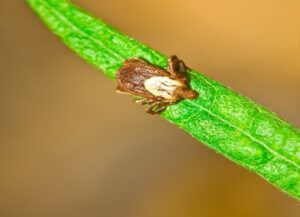
Rocky Mountain Wood Tick
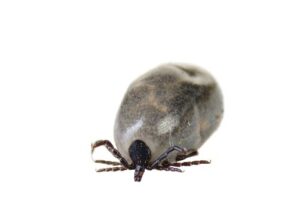
Western Black Legged Tick
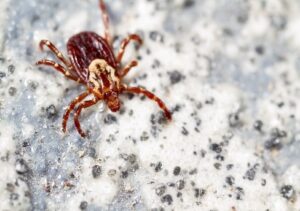
American Dog Tick
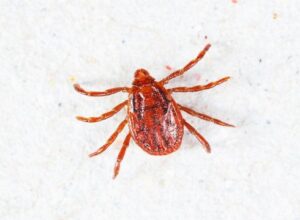
Brown Dog Tick
Diseases spread by ticks found in Nevada include Rocky Mountain spotted fever, Colorado tick fever, Tularemia, Anaplasmosis, Borrelia and Lyme disease. Your risk for disease is very low if a tick has been attached for less than 24 hours but it is important to monitor yourself for symptoms after you have been bitten. Check for ticks daily if you’ve been in grassy wooded areas and remove them from your body as soon as possible. Make sure to ask a parent or adult for help when removing ticks.
Preventing Tick Bites on People
Tick exposure can occur year-round, but ticks are most active during warmer months (April-September).
Before You Go Outdoors:
- Know where to expect ticks. Ticks live in grassy, brushy, or wooded areas, or even on animals. Spending time outside walking your dog, camping, gardening, or hunting could bring you in close contact with ticks. Many people get ticks in their own yard or neighborhood.
- Treat clothing and gear with products containing 0.5% permethrin. Permethrin can be used to treat boots, clothing and camping gear and remain protective through several washings. Alternatively, you can buy permethrin-treated clothing and gear.
- Use insect repellents while hiking, camping, hunting or being outside. Ask an adult for help when putting on insect repellent.

- Avoid Contact with Ticks
- Avoid wooded and brushy areas with high grass and leaf litter.
- Walk in the center of trails.
- Check your clothing for ticks. Ticks may be carried into the house on clothing. Any ticks that are found should be removed. Tumble dry clothes in a dryer on high heat for 10 minutes to kill ticks on dry clothing after you come indoors. If the clothes are damp, additional time may be needed. If the clothes require washing first, hot water is recommended. Cold and medium temperature water will not kill ticks.
- Examine gear and pets. Ticks can ride into the home on clothing and pets, then attach to a person later, so carefully examine pets, coats, and daypacks.
- Shower soon after being outdoors. Showering may help wash off unattached ticks and it is a good opportunity to do a tick check. Showering within two hours of coming indoors has been shown to reduce your risk of getting tickborne diseases.
- Check your body for ticks after being outdoors. Conduct a full body check upon return from potentially tick-infested area. Check these parts of your body and your child’s body for ticks:
- Under the arms
- In and around the ears
- Inside belly button
- Back of the knees
- In and around the hair
- Between the legs
- Around the waist
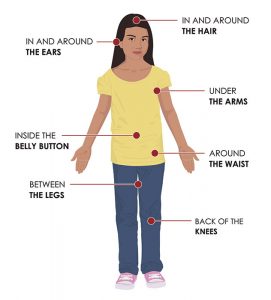
Preventing Tick Bites on Your Pet
Pets can get tick bites and tickborne diseases very easily. However, tick bites on pets can be harder to detect. Vaccines are not available for most of the tickborne diseases that pets can get, and they don’t keep pets from bringing ticks into your home. For these reasons, it’s important to use the following measures for your pets:
- Check your pets for ticks daily, especially after they spend time outdoors.
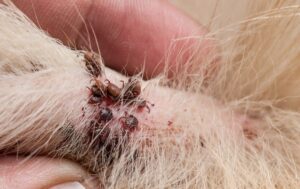
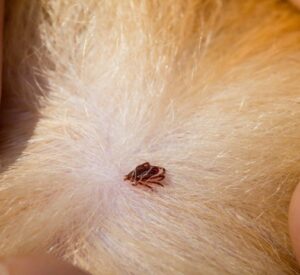
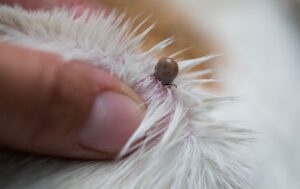

- If you find a tick on your pet, remove it right away.
- Reduce tick habitat in your yard.
- Remove piles of leaves.
- Clear tall grasses and brush around homes and at the edge of lawns.
- Place a 3-ft wide barrier of wood chips or gravel between lawns and wooded areas to keep ticks from migrating into recreational areas.
- Mow the lawn frequently.
- Stack wood neatly and in a dry area (this will help discourage rodents).
- Keep playground equipment, decks, and patios away from trees and bushy areas.
- Try to keep unwelcome animals (such as deer, raccoons, and stray dogs) from entering your yard by using fences.
- Remove old furniture, mattresses, or trash from the yard that may give ticks a place to hide.
Signs of tickborne disease may not appear for 7-21 days or longer after a tick bite, so watch your pet closely for changes in behavior or appetite if you suspect that your pet has been bitten by a tick.
Talk to your veterinarian about:
- The best tick prevention products for your pets
- Tickborne diseases in your area
Note: Cats are extremely sensitive to a variety of chemicals. Do not apply any tick prevention products to your cats without first asking your veterinarian!
What to do if you find a tick bite on you or your pets (an adult or parent should help you with the following)
- Disinfect the bite area.
- Use fine-tipped tweezers to grasp the tick as close to the skin as you can.
- Pull upward with steady, even pressure. Don’t twist or jerk the tick.
- After removing the tick, clean the bite area and your hands with rubbing alcohol or soap and water.
- Dispose of the tick by flushing it down the toilet. If you would like to bring the tick to your healthcare provider for identification, put it in rubbing alcohol or place it in a sealed bag/container.

For more information on the signs and symptoms of each of the diseases spread by ticks in Nevada, you can search for the disease here.
Back to All